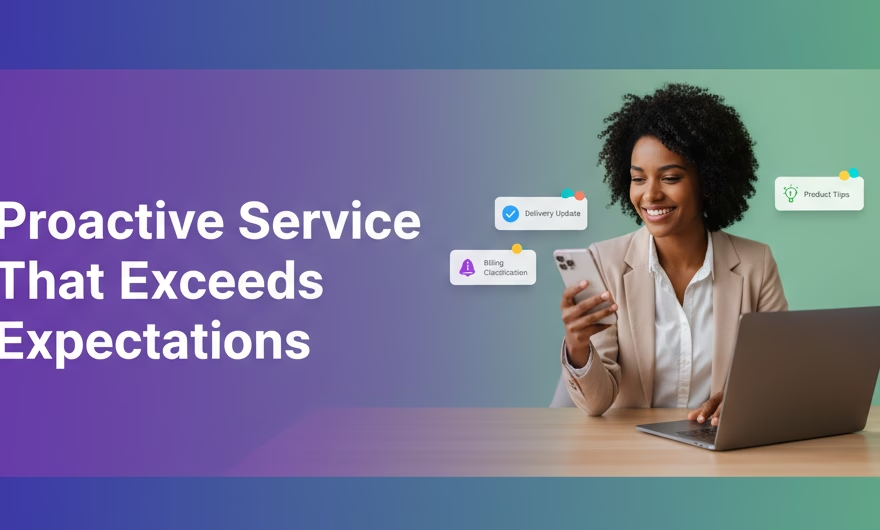Proactive customer service is about anticipating customer needs and addressing them before the customer reaches out. It goes beyond reactive support by predicting issues and delivering solutions that delight customers and strengthen loyalty. When done well, proactive service transforms interactions from problem-solving to experience-building, helping customers feel informed, confident, and valued at every step of their journey.
What Is Proactive Customer Service?
Proactive service means engaging with customers in advance of potential challenges, providing information, support, and solutions preemptively. It focuses on prevention rather than response, aiming to exceed customer expectations by making their experience seamless and hassle-free.
In practice, this looks like reaching out before a billing date to clarify charges, notifying customers about expected delivery changes, sharing product tips after activation, or alerting users about unusual account activity. Proactive engagement can happen across channels—SMS, WhatsApp, email, in-app messages, voice, or social—based on customer preference and context. The goal is to eliminate surprises, reduce effort, and ensure customers get value without having to ask.
Why Proactive Customer Service Matters
Proactive customer service is a differentiator because it reduces uncertainty and builds confidence. By addressing needs before they arise, brands reduce friction and create positive moments that compound over time.
- Prevents issues from escalating, reducing customer frustration. Early alerts, status updates, and clear next steps stop small hiccups from turning into bigger problems.
- Builds trust and loyalty by showing customers you care. Anticipatory support signals accountability and empathy, reinforcing long-term relationships.
- Enhances the overall customer experience. Proactive guidance keeps journeys smooth, reduces effort, and helps customers achieve outcomes faster.
- Creates opportunities for upselling and cross-selling through timely recommendations. When tied to intent and context, suggestions feel helpful rather than intrusive.
Strategies to Exceed Customer Expectations
- Anticipate Needs Using Data:
Leverage customer data analytics to identify patterns and forecast potential issues or demands. Use journey maps and behavioral signals—such as repeat login failures, declining usage, or pending warranty expirations—to trigger timely interventions. Combine historical interactions, product telemetry, and seasonality to predict peaks or risks, then craft outreach playbooks that offer guidance, alternatives, or preventive fixes.
- Personalized Communication:
Tailor outreach based on past interactions and preferences to make customers feel understood. Personalization goes beyond using a name; it aligns messages with lifecycle stage, purchase history, channel preference, and sentiment. For example, send setup tips to new users, advanced best practices to power users, and concise status alerts to customers who prefer SMS. Respect frequency caps and timing to avoid overwhelming customers.
- Proactive Outreach:
Contact customers with helpful information, updates, or solutions before they request assistance. Examples include outage notifications with ETAs, shipment updates with self-reschedule links, or reminders ahead of renewals and appointments. Offer clear next steps and self-service options to resolve issues instantly. Measure the impact through reduced inbound volume on predictable topics and improved customer satisfaction on affected journeys.
- Empower Customer Service Teams:
Train staff to anticipate problems and provide proactive solutions confidently. Equip agents with contextual dashboards—recent activity, open orders, sentiment, and likely next issues—so they can address future needs during current conversations. Encourage “next best action” practices, such as confirming preferred channels, setting expectations for upcoming milestones, and documenting follow-ups to close the loop proactively.
- Utilize Automation:
Use automated notifications for order status, service updates, or tips to keep customers informed. Intelligent routing, proactive chat prompts, and IVR callbacks reduce wait times and effort. Automation should feel human: segment by relevance, provide opt-out controls, and keep messages concise and helpful. When automation detects complexity or urgency, hand off to a human with full context to avoid repetition.
- Collect and Act on Feedback:
Regularly gather customer insights through surveys and social listening to refine proactive efforts. Monitor recurring issues, analyze verbatim comments, and track the moments where customers get stuck. Convert insights into specific improvements—new knowledge base articles, clearer onboarding flows, or updated policies—and close the loop by informing customers when changes are made in response to their feedback.
Benefits of Proactive Customer Service
- Improved Customer Satisfaction:
Addressing issues early leads to smoother experiences. Customers appreciate timely guidance and transparency, especially when you provide solutions alongside notifications. This reduces the emotional cost of uncertainty and converts potential pain points into positive moments.
- Increased Customer Loyalty:
Customers feel valued when their needs are anticipated. Consistent, thoughtful outreach builds familiarity and trust, making customers more likely to stay, recommend your brand, and explore additional products or features over time.
- Cost Savings:
Preventing problems reduces the volume and complexity of support requests. When customers receive relevant updates, self-service options, and clear next steps, inbound contacts drop on predictable issues—freeing teams to focus on high-value conversations.
- Enhanced Brand Image:
Demonstrating care through proactive service differentiates the brand. Companies known for transparency and anticipation of needs turn service into a competitive asset, not merely a cost center.
Implementing Proactive Customer Service
To implement a proactive approach, companies should align teams, data, and processes around prevention and clarity. Start with a few high-impact journeys, then expand as you validate impact and refine playbooks.
- Develop clear objectives focusing on proactive support metrics. Track proactive contact rate, reduction in avoidable contacts, resolution time, and satisfaction on journeys touched by proactive outreach.
- Invest in data analytics and AI tools to foresee customer needs. Use signals like churn risk, intent, and event thresholds (e.g., delays, errors) to trigger timely, relevant messages.
- Establish self-service resources to empower customers. Keep knowledge bases, FAQs, and in-app guides updated; link them directly from proactive notifications for immediate resolution.
- Automate routine communications while maintaining personal touches. Build templates with dynamic fields and human review for sensitive or high-stakes scenarios.
- Continuously train teams on proactive problem-solving. Coach agents to set expectations, confirm preferences, and preempt next issues during every interaction.
- Create a feedback loop to monitor and improve proactive initiatives. Review performance weekly, capture agent and customer inputs, and iterate on triggers, content, and timing.
By embracing proactive customer service, businesses do not just meet but exceed customer expectations, fostering loyalty, reducing churn, and gaining competitive advantage. Anticipation, transparency, and timely guidance create experiences that customers remember—and return for. Start with the moments that matter most, build reliable playbooks, and let proactive service become the signature of your brand’s commitment to customer success.




